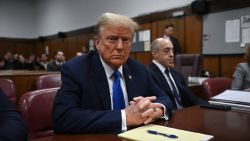A version of this story appeared in CNN’s What Matters newsletter. To get it in your inbox, sign up for free here.
The second impeachment trial of President Donald J. Trump is underway. It is only the fourth impeachment trial in US history, and the first time a president has been tried after leaving office – as well as for a second time.
The House managers prosecuting Trump will not make acquitting him easy for Republicans. Their opening – in the very building that was the scene of the crime – was effective and emotional. They began the trial, which today was focused on the constitutionality of an impeachment trial for a former president, with a shocking montage of video of Trump egging on supporters who quickly became rioters.
The case to proceed with impeachment
You can make video do whatever you want. But this was a remarkable presentation, which was followed by a Constitution- and history-heavy examination of why it’s not only right, but necessary to hold these proceedings.
It culminated with the lead House manager Rep. Jamie Raskin, a newly bereaved parent, talking about the fear sparked in him and his remaining children by the President’s mob. Watch him describe the experience of not being able to safely reach his children, who had joined him that day but were in a different part of the building.
Then read his words:
You know what she said? she said, “Dad, I don’t want to come back to the Capitol.” Of all of the terrible, brutal things that I saw and that I heard on that day, and since then, that one hit me the hardest. That, and watching someone use an American flagpole, with the flag still on it, to spear and pummel one of our police officers ruthlessly – mercilessly tortured by a pole with a flag on it that he was defending with his very life.
People died that day.
Officers ended up with head damage and brain damage.
People’s eyes were gouged. An officer had a heart attack.
An officer lost three fingers that day.
Two officers have taken their own lives.
Senators, this cannot be our future.
This cannot be the future of America. We cannot have presidents inciting and mobilizing mob violence against our government and our institutions because they refuse to accept the will of the people under the Constitution of the United States. Much less can we create a new January exception in our precious, beloved Constitution that prior generations have died for and fought for, so that corrupt presidents have several weeks to get away with whatever it is they want to do. History does not support a January exception in any way, so why would we invent one for the future?
CNN’s Manu Raju reported there was little indication any minds were changed after the Democratic presentation. Sen. Rand Paul was seen doodling. Others were furiously scribbling notes during the fact-heavy arguments.
The case to just drop it
Yet the opening argument had Trump’s lawyers spinning, trying to reformulate at the last minute. They switched speaking order, putting Bruce Castor, the former Pennsylvania attorney general and top Trump lawyer, first.
He opened his rambling arguments by casting the rioters aside. You won’t hear anyone from Trump’s team give them comfort, he said, and warned that impeaching Trump now will clamp down on the freedom of speech and push the US toward a king.
“We can’t possibly be suggesting punishing people for political speech in this country,” he said, trying to draw a line between Trump’s speech and the mob’s actions.
Impeachment, he warned, will become a biannual exercise if it’s allowed to go forward. And voters showed the system worked, he argued, by choosing Joe Biden. (Trump will hate that).
Angry at the show on TV, Trump was borderline screaming while he watched, according to reporting from CNN’s Kaitlan Collins.
Trump’s former impeachment lawyer Alan Dershowitz, who defended him in the Ukraine trial, told the conservative news outlet Newsmax that he had “no idea” what Castor was doing.
Trump’s second attorney, David Schoen, tried to make the case that Democrats were trying to disenfranchise Trump’s supporters – the same thing Trump himself claimed in the January 6 remarks that preceded the insurrection and that are at the heart of the incitement charge being litigated.
Here’s how Schoen summed up the case:
Let’s be crystal clear on where we stand and why we are here. The singular goal of the House managers and House leadership in pursuing impeachment conviction of Donald J. Trump is to use these proceedings to disenfranchise at least 74 million Americans with whom they viscerally disagree, and to ensure that neither they nor any other American every again can cast a vote for Donald Trump.
And if they convince you to go forward, their ultimate hope is that this will be a shot across the bow of any other candidate for public office who would dare to take up a political message that is very different from their own political point of view as the direction in which they wish to take our country. Under our Constitution, this body and the impeachment process must never be permitted to be weaponized for partisan political purposes. This article of impeachment must be dismissed for lack of jurisdiction based on what we have discussed here today and what’s in our brief. The institution of the presidency is at risk unless a strong message is sent by the dismissal of the article of impeachment.
Unsaid by Trump’s defense: The former President’s public effort to clamp down on the democratic election that selected Biden as President.
It’s easy to criticize the President’s attorneys for mostly ignoring the facts and sidestepping key issues. But the larger problem for them is their defendant, who switched lawyers at the last minute and has deep thoughts on how his defense should work.
One more Republican sided with Democrats. Senators voted 56-44 that the trial is constitutional and will carry on with the proceedings on Wednesday. Six Republicans sided with Democrats, which is one more than voted that way last week.
The switch was Sen. Bill Cassidy of Louisiana. After the vote, Cassidy explained this way: “If I’m an impartial juror trying to make a decision based on the facts as presented on this issue, then the house managers did a much better job,” he told reporters on Capitol Hill.
CNN’s Ted Barrett asked Cassidy if he was also open to convicting Trump.
“I’ve always said I’m approaching this as an impartial juror,” Cassidy said.
Insurrection impeachment vs. Ukraine impeachment
The historical arc of this thing is nothing short of incredible. A president who survived impeachment for trying to stack the deck against his most-feared election opponent is now facing impeachment again for inciting his supporters to attack Capitol Hill to challenge that same opponent’s victory.
Then, it was complicated. There was a whistleblower, an investigation, a long series of hearings, a lot of debate, and finally an impeachment.
Now, it’s very simple. It’s a matter of whether you saw Trump’s followers storm the Capitol and think he bears any responsibility.
Acquittal is still the expected outcome. It’ll take 17 Republicans siding with Democrats to convict and that seems like a very steep hill. And this trial is just getting started.
We know one thing about how this ends. Whatever the outcome of the Senate vote, President Joe Biden is in the White House. The leadership of the executive branch is not at stake. That wasn’t true during Trump’s first trial.
Gilded Age impeachment, revisited
Senators can argue about whether it’s constitutional to try a former official, but they can’t argue about whether it’s been done before. It has for William Belknap in 1876. During the Gilded Age, so-dubbed by Mark Twain, the Secretary of War to Ulysses Grant was caught taking kickbacks and funding a lavish lifestyle – accounts all seem to note how Belknap’s first and second wife were extravagantly dressed.
Caught, Belknap begged his friend and boss, Grant, to accept his resignation. He was at turns on his knees begging Grant and in tears, grasping Grant’s hand, according to the lore. This image, from Frank Leslie’s Illustrated Newspaper, is in the Senate archive and appears to show the weeping Belknap before Grant allows him to resign. He was impeached and tried, which is bad news for Trump. But he was ultimately acquitted by the Senate, which might be good news for the former President – although Belknap’s corruption is a much different thing than Trump’s insurrection.
The author and presidential historian Thomas Balcerski commented, “The arguments for the legality of Belknap’s impeachment, then as today, hinge on the word ‘and.’ Should it be removal AND disqualification as one discrete set of actions, or something more akin to today’s use of ‘and/or.’ In 1876 and 2021 alike, the votes in favor of the trial’s Constitutionality have exceeded those against it.”
So many constitutional questions come down to grammar. The text Balcerski is talking about is this, from Article 1, Section 3: “Judgment in Cases of Impeachment shall not extend further than to removal from Office, and disqualification to hold and enjoy any Office of honor, Trust or Profit under the United States: but the Party convicted shall nevertheless be liable and subject to Indictment, Trial, Judgment and Punishment, according to Law.”
The Constitution is full of confusing commas. Check out the Second Amendment and see if you think they were talking about individuals bearing arms, or militias.
Here’s that: “A well regulated Militia, being necessary to the security of a free State, the right of the people to keep and bear Arms, shall not be infringed.”

















